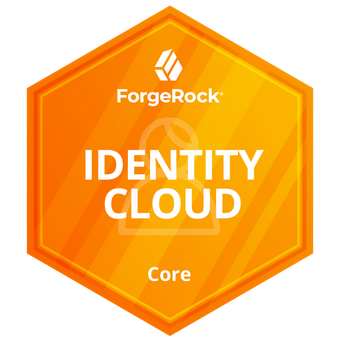

Getting Started With ForgeRock® Identity Cloud
(IC-300)
This course takes students from a high-level understanding of how ForgeRock® Identity Cloud (Identity Cloud) works, through the various online resources available to them, to a fully functional hands-on development environment, where they learn how to implement the many features of Identity Cloud in a training environment. Students take real-world use cases and implement them in a provided live Identity Cloud environment, where they learn the concepts and tasks necessary to successfully manage identities, applications, and user journeys in their own Identity Cloud.
Target Audiences
The target audiences for this course include:
- ForgeRock Identity Cloud Administrators
- Technical users new to ForgeRock Identity Cloud and other ForgeRock products
- Those new to Identity Cloud and considering taking the certification exam
Objectives
Upon completion of this course, you should be able to:
- Describe the benefits and features of Identity Cloud and how to access an Identity Cloud tenant as an administrator
- Manage the onboarding of users through self-service, understand managed objects, import identities, and synchronize identities between Identity Cloud and external resources
- Manage journeys to support how end users authenticate and perform self-service with Identity Cloud
- Integrate application client profiles and gateway profiles into Identity Cloud to support external applications accessing Identity Cloud for identity and access management services
- Manage federation to let employees with credentials stored in a remote Active Directory (AD) data store access services in Identity Cloud
Prerequisites
The following are the prerequisites for successfully completing this course:
- Completion of the ForgeRock Product Essentials courses available at: https://backstage.forgerock.com/university/cloud-learning
- ForgeRock® Access Management Essentials
- ForgeRock® Identity Management Essentials
- ForgeRock® Identity Gateway Essentials
- ForgeRock® Directory Services Essentials
Duration
3 days
Course Contents
Chapter 1: Introducing ForgeRock Identity Cloud
Describe the benefits and features of Identity Cloud and how to access an Identity Cloud tenant as an administrator.
Lesson 1: Introducing Identity Cloud
Provide an overview of Identity Cloud, and the onboarding process:
- Describe Identity Cloud
- Explain Identity Cloud onboarding services
Lesson 2: Getting Access to Identity Cloud
Describe Identity Cloud tenant registration:
- Describe the tenant registration process
- Introduce the Identity Cloud Admin UI
Chapter 2: Managing User Identities
Manage the onboarding of users through self-service, understand managed objects, import identities, and synchronize identities between Identity Cloud and external resources.
Lesson 1: Managing Identities
Manage user identities and invite additional administrators using the Identity Cloud Admin UI, which is an administrative interface to manage your tenant settings:
- Manage user profiles in Identity Cloud
- Manage a user profile in Identity Cloud
- Manage administrators
- Invite a top-level administrator
- Explain UI integration options
- Configure themes for the Alpha and Bravo realms
- Manage password policies
- Configure password policies
Lesson 2: Onboarding Users With Self-Service
Add new users to your tenant through self-registration:
- Describe self-registration
- Register a user
- Describe self-service
- Explore self-service features
Lesson 3: Introducing Organizations
Explain how an organization hierarchical structure can be used to model a brand hierarchy to control access to business applications:
- Explain how to model an organization structure
Lesson 4: Adding Identities With Bulk Import
Bulk import user identities from a CSV file:
- Describe bulk import
- Import customers and employees
Lesson 5: Extending the User Identity Schema
Extend the user identity schema to store and display custom properties:
- Manage placeholder properties
- Customize placeholder properties
- Describe how to use custom attributes
- Add custom attributes
Lesson 6: Synchronizing Identities From External Resources
Connect to external resources using a Remote Connector Server (RCS), and synchronize identities between Identity Cloud and on-prem resources:
- Explain how to connect to external resources
- Configure a connection between Identity Cloud and an external ForgeRock® Directory Services (DS)
- Explain synchronization
- Populate Identity Cloud with DS entries
- Configure bi-directional synchronization
- Populate Identity Cloud with AD users
- Configure an RCS Cluster (optional)
Lesson 7: Managing Provisioning Roles and Assignments
Manage provisioning roles and assignments to dynamically provision attributes to external resources:
- Introduce provisioning roles and assignments
- Create assignments and provisioning roles
Lesson 8: Additional Administration Tasks
Explain additional tasks that an Identity Cloud administrator should be aware of:
- Add a custom domain name
- Introduce Identity Cloud REST APIs
- Explore logs
- Monitor your tenant
- View the Identity Cloud analytics dashboard
- Describe how to manage environment secrets and variables
- Create and call an environment variable
Chapter 3: Managing User Journeys
Manage journeys to support how end users authenticate and perform self-service with Identity Cloud.
Lesson 1: Exploring Default Journeys
Describe the default journeys included with Identity Cloud, and explore self-service journeys as an Identity Cloud administrator and end user:
- Introduce journeys
- Explain self-service journeys
- Explore self-service journeys
Lesson 2: Modifying Journeys
Use the journey editor in Identity Cloud to manage a journey, and understand the use of authentication nodes and email templates in a journey flow:
- Introduce authentication nodes
- Manage journeys
- Group journeys
- Modify the Login journey
- Explore email templates and nodes
- Configure email templates
- Modify an email template
- Describe how to debug a journey
- Enable debug mode on a user journey
Lesson 3: Configuring Self-Service
Configure the self-service features of Identity Cloud to empower end users to independently make changes to their identity, instead of going through a help desk:
- Explore knowledge-based authentication (KBA) options
- Configure self-service to use KBA
- Explain terms and conditions
- Configure terms and conditions
Lesson 4: Configuring Social Registration and Authentication
Configure Identity Cloud to let end users register and authenticate new accounts using a social provider:
- Explain social registration and authentication
- Configure an OAuth 2.0 (OAuth2) client for Identity Cloud and configure Google as an identity provider
- Add social registration to the Registration journey
- Add social authentication to the Login journey
Lesson 5: Importing and Exporting Journeys
Import and export user journeys using the Identity Cloud Admin UI:
- Describe how to export and import journeys
- Export and import journeys
Chapter 4: Integrating Applications and Gateways
Integrate application client profiles and gateway profiles into Identity Cloud to support external applications accessing Identity Cloud for identity and access management services.
Lesson 1: Defining Applications
Describe the role of an application in Identity Cloud:
- Describe supported application types
Lesson 2: Adding an Application Client Profile
Add a new application client profile in Identity Cloud for a ForgeRock SDK sample application, and validate the application can authenticate with Identity Cloud using the client profile:
- Explain how the ForgeRock SDKs are used with Identity Cloud
- Add an SPA
- Enable a JavaScript application to use Identity Cloud for authentication
Lesson 3: Integrating Identity Gateway
Show how Identity Gateway can protect an application when it is integrated with Identity Cloud:
- Introduce Identity Gateway
- Integrate Identity Gateway with Identity Cloud
- Integrate the Identity Gateway sample application with Identity Cloud
Chapter 5: Managing Federation
Manage federation to let employees with credentials stored in a remote AD data store access services in Identity Cloud.
Lesson 1: Integrating Third-Party Services using SAML
Integrate Identity Cloud with a third-party provider using SAML v2.0 (SAML) to provide single sign-on (SSO) services:
- Introduce Federation
- Explain how to configure Identity Cloud as an SP
- Configure Identity Cloud as an SP
- Explain how to configure ADFS as an IdP
- Configure ADFS as an identity provider (IdP)
- Explain how to configure Identity Cloud to use an IdP
- Configure Identity Cloud to use an IdP
Summary of differences between FR-300 Rev C and IC-300 Rev A
- Content regarding accessing your tenant has been removed from this course release due to the changes for the On Demand model.
- The analytics dashboard within the Identity Cloud Admin UI is introduced with a further dive into how to manage environment secrets and variables within additional administration tasks of Chapter 2.
- Chapter 3 includes a new section/exercise on how to use the debug mode on a user journey to help troubleshoot journey issues and includes new UI enhancements on how to group journeys and configure the email templates.
- Chapter 4 covers a new version of the SDK sample app.
- Chapter 5 contains updated information on how to download and fix the ADFS metadata.








